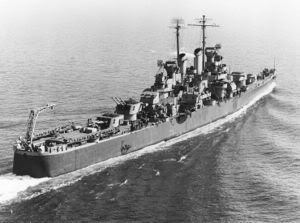Leyte Gulf, October 1944, an all out attack by Japanese Air Forces based on Formosa, Kyushu and the Phillipines assaults the Seventh Fleet.
The Japanese expect, report, believe and let their own people to believe that the massive air assault (to be detailed later) inflicts crippling losses on the American Fleet.
In Fact, 500-1200 Japanese Aircraft of all types are Clawed out of the sky by The Fleets CAP and antiaircraft defenses.
The landings proceed unhindered.
Coincidences and Ironies:
October 24, 1944; A lone Japanese Aircraft slips under radar and airborne surveilance and hits the Light Carrier Princeton with a single 550 Kilogam aerial bomb.
Princetons aircraft are on deck, rearming is underway.
Princeton is in serious trouble and it's Captain goes to the flight deck.
A light Cruiser Pulls alongside to assist.
Suddenly a massive explosion wracks the Princeton.
Over one hundred men engaged in damage control, controlling fires and hosing down the hangar and flight deck array of weapons are killed.
The On deck loads have cooked off.
I recall the Princeton's Captain has his leg blown off in the explosion.
Simultaneously the Light Cruiser's deck is swept by shrapnel and a crewman's leg is blown off, among countless other casualties.
The Captain is later depicted in a late 50's movies.
He is allowed to stay in the Navy, citing John Paul Jones as an example. he is played by the later expatriate actor Sterling Hayden.
The Light Cruiser's crewman mentioned later writes about his loss of limb in WWII Magazine: "One Leg in the Grave".
The Princeton and the Light Cruiser share the same hull design.
I may be able to find the name of the Captain and crewman if I search through my own archives and the Web.
I am also looking for the name of the Light Cruiser.
Later in the Battle of Surigao Strait, billed as the last action of the Heavies, a beleagured and damaged column of Japanese warships tries to force the Strait.
A line of Battleships, most of of which have been raised from the Bottom at Pearl and/or are survivors of Dec. 7, 1941, under Adm. Jesse Oldendourf crosses the decimated Japanese column's 'T" at Surigao Strait.
The only Battleship remaining in the Japanese Force is "Yamashiro" it sinks under a rain of shells.
Yamashiro was designed by an English Naval Architect; Sir George Thurston.
As an aside night surface actions were the exclusive domain of surface ships during world War II.
Even American Submarines attacking at night attacked on the Surface.
Aircraft and particulary carrier based aircraft could not operate effectively against sea surface targets at night at this time.
I know a smattering of other type aircraft do not fit this general rule. (PBM'S PBY'S? P-61 Black Widow, the latter an impressively armed night fighter.)
Surigao Strait, Leyte Gulf, Subayan Sea, San Bernadino Strait and other related surface actions, generally will, I hope, be covered in later threads.
Only one of the Old Battleships was unable to acquire a target at Surigao. Little of the original japanese surface force assigned to force the Strait remained left after repeated attacks by Oldendourf's PT's, cruisers and destroyers.
I am searching for some source books here to flesh this out.
All the above was written from memory except for the date of the action.
In an unrelated bit of trivia while researching a matter for a future thread i came accross the list of the Dead from the Alamo. Among those not tejano was listed the decidedly Anglo name of John Thurston.
Quite sobering really.

Birmingham Alongside Pricetion before the explosion.
JT






